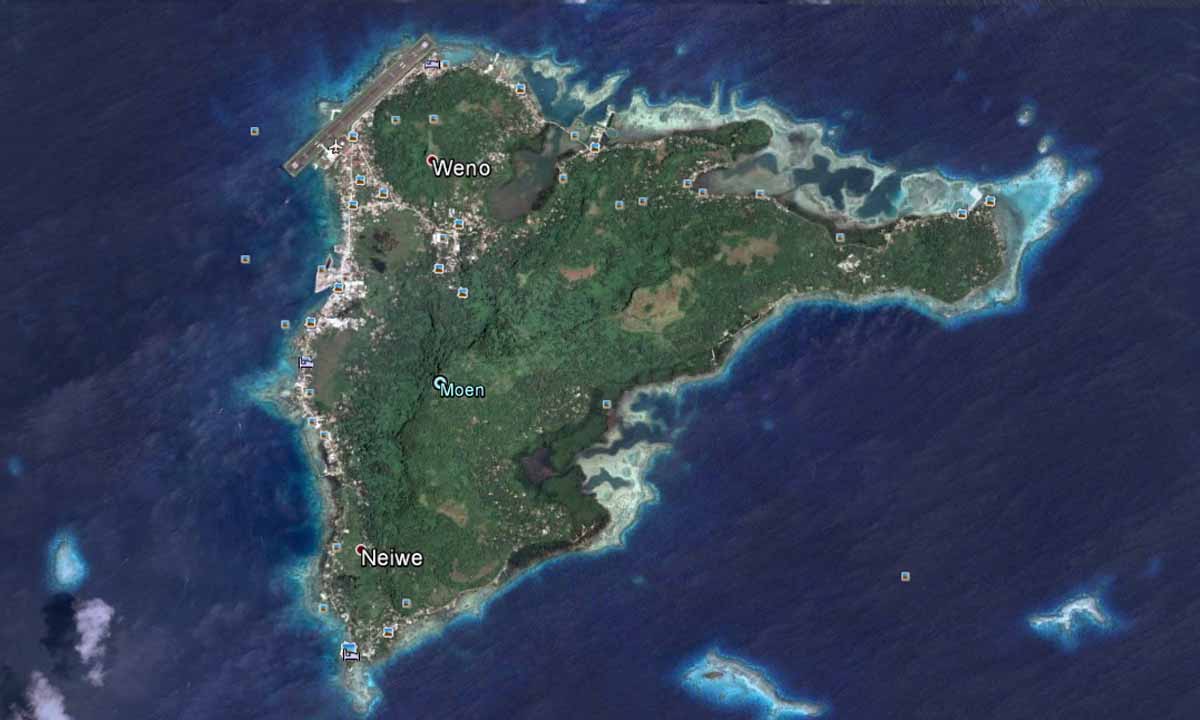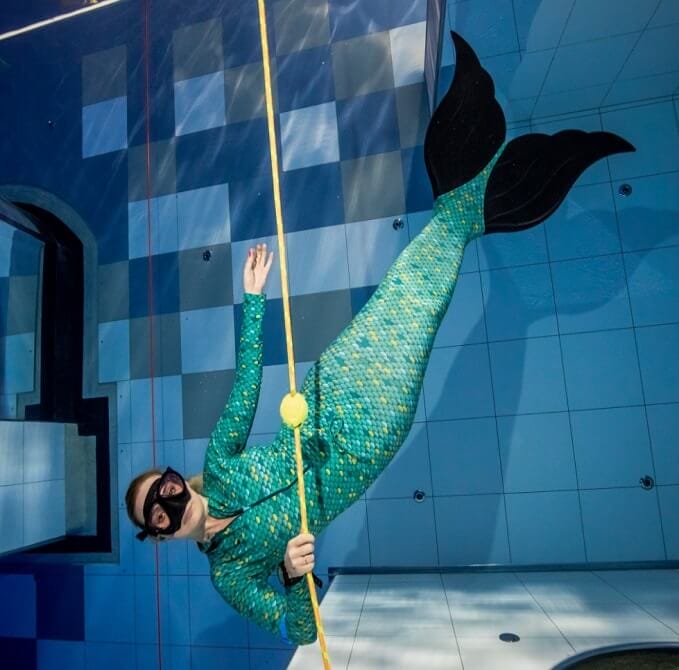When you like wrecks there is one name that opens up a simply beautiful dream in your mind, that name is Laguna Truk. Just look at the map, all around is simply the space of the Pacific Ocean. The vast mighty Pacific Ocean and somewhere in that space the tiny yet huge Truk Lagoon.
When we made the effort to go there it was just a rather large transportation and logistics undertaking at first, especially since we were planning more advanced dives. If we need more equipment, then transporting divers and crates of equipment is quite a challenge. Flying through Manila in the Philippines, Guam which is a U.S. military base in the Pacific and then already flying to Truk is a long and quite exhausting route. A two-day tour with total time reversal. Since Laguna Truk is practically on the other side of the globe – the time difference is 11 hours. Confused by successive airports, flights, the reversal of day and night, we finally saw the blue lagoon under the wings of our plane. After landing on Truk, you might think that an islet like an islet, you can see that it rains a lot. Water-logged asphalt, but asphalt nonetheless. Puddles. This is an area where even in the dry season it rains almost every day. Airport of those where in the corner of the airport there is a pole at which on the right it says “exit” and on the left hangs a sign that says “entrance.” Outside a bit of roaming cabs well and transport to our dive base and hotel.
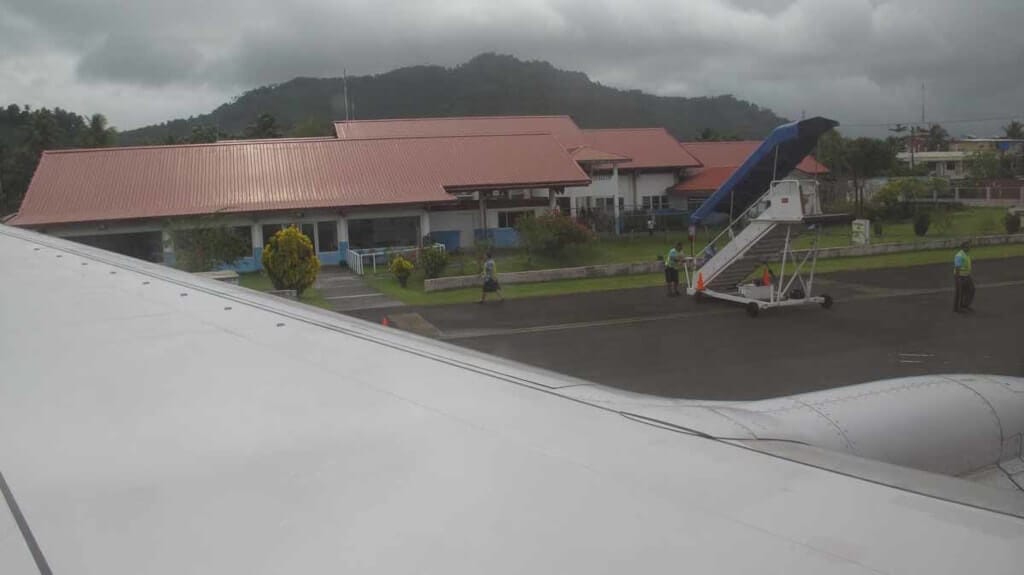
Truk is a lagoon and a collection of Micronesian-style islets, i.e. old volcanic cones protruding from the sea and overgrown with jungle. It is surrounded by a blue Lagoon with a distant barrier of coral reefs. This is not a Lagoon in the style of low sandbars or Polynesian islets, but just flooded with frequent rains, overgrown with dense jungle, post-volcanic cones.
Truk is generally such a very remote place. Of course, civilization has already arrived everywhere. Everyone walks around in t-shirts and flip-flops, but at the same time there are balsa wood laundry trowels made from balsa wood on the washing powder shelf at the local supermarket. Such laundry trowels by the method of smashing laundry on a flat stone on the riverbank and are not artifacts for tourists. Just a laundry pack for one dollar if you can’t afford a generator and an automatic washing machine. In stalls they sell such a beverage Kava – and it’s definitely not coffee. They also sell betel which is such a strange chewing powder from which you get red gums.
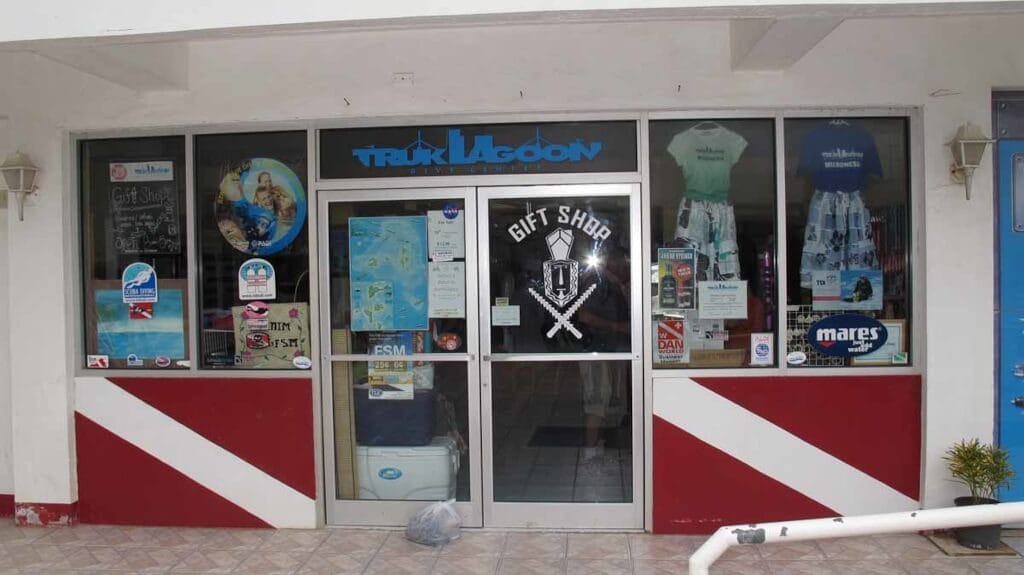
Truk trumps most of the world’s wrecking sites in one respect. First, wreck sites are often bays and there are beautiful wrecks but very poor visibility. Truk is an amazing 40-meter transparency. Just a moment later, at the beginning of the descent down below us, massive wrecks appear. The second advantage of Truk is the incredible amount of artifacts in the wrecks. It’s just that in the days when wrecks were still being looted Truk was too far away for there to realistically be that many divers there to pull out what lay there. And now such things simply don’t get done anymore, so the wrecks of the Truk Lagoon are filled with ammunition, weapons, bullets, and sometimes the bones of Japanese sailors.
Briefing, preparing equipment for the next day, talking to the owners of the base, or Dive Shop, as it is still called in the American dive zone, well, and thinking about what’s coming tomorrow. Guides at this remote site, which is also far from civilization and far from decompression chambers, while there is a large accumulation of deep dives, have developed some specific standards on how to dive in order to dive a lot, deeply and yet not hit decompression chambers too often. First of all, we drink a lot of water. They force us to do it on the boat. Everyone has a signed cup into which, in addition to what we drink, water is poured several times during the day, and they carefully watch to make sure we drink this cup of clean water. A simple effective method, a mug with your name written in marker. Since divers already, when they have flown this far, want to dive a lot and deep, the next standard is two dives per day with the first being a typical decompression dive according to the plan a given diver wants to follow and a second afternoon dive, formally non-decompression on nitrox and ending with a 10-minute “safety stop” on pure oxygen (such a cleanup of nitrogen and maybe even mythical microbubbles).
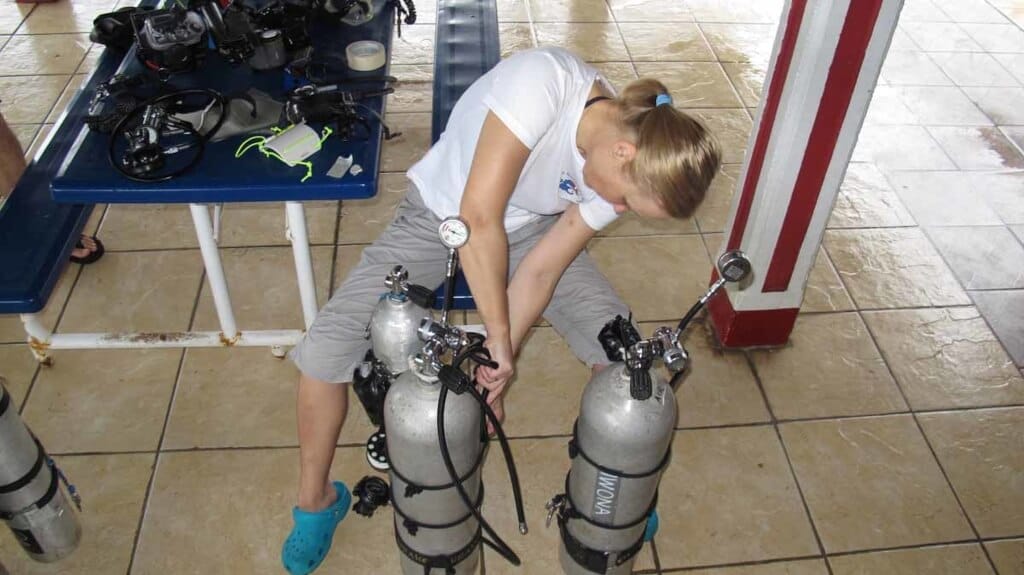
Decompression dives on deeper wrecks are usually conducted at depths between forty, fifty-something and sixty meters. The guides bring the group aboard the wreck showing interesting features and taking those willing to go on penetration dives deep into the wreck, really showing the thousands of artifacts there. From Japanese porcelain through ammunition. Both simply oozing out of bins of thousands of machine gun cartridges to powerful bullets for Japanese 15-inch caliber battleships.
Truk lagoon wrecks
Most of the wrecks lie in the triangle between the islands of Moen, Dublon and Fefan.
- Aikoku Maru
- Amagisan Maru
- Betty Bomber
- Fujikawa Maru
- Fumitsuki
- Heian Maru
- Hoki Maru
- Kiyosumi Maru
- Nippo Maru
- Rio de Janeiro Maru
- San Francisco Maru
- Seiko Maru
- Uikai Maru
- Yamagiri Maru
History and geography of the lagoon
Truk Lagoon is now known as Chuuk State in the Federated States of Micronesia.
Truk Atoll became subject to Japan after World War I when many Micronesian islands were taken from Germany and given to Japan as its mandated territories.
In the 1930s, Japan began to establish a massive naval base on Truk for aircraft carriers and a fleet of seaplanes. The Lagoon was sheltered from waves by an atoll of reefs, while at the same time the surrounding islands shielded the Lagoon from strong winds. After Japan’s withdrawal from the League of Nations in 1933, Japan was no longer constrained by the established rules of peace conferences and Japan began fortifying bases in the Pacific at a very rapid pace. Laguna Truk has become the “home” of the powerful “combined” Pacific Fleet (Combined Fleet).
As the Truk Lagoon base blocked the possibility of an attack toward the main Japanese islands on February 17 and 18, 1944 came the American air strike on Truk Lagoon.
Unfortunately for today’s divers, the warships left Truk Lagoon before the attack. Only the transport and supply ships of the Japanese fleet remained there. Hence, what you can see on the bottom are massive ships with huge amounts of artifacts – weapons, aircraft in parts, and we can’t admire the powerful artillery of Japanese warships.
However, lying at the bottom of the Truk Lagoon, some 45 wrecks form the world’s largest shipwreck site.
For the diving world, this amazing site (like many other sites) was discovered by Jacques Cousteau’s expedition in 1970. And since then, Laguna Truk has become a “Mecca” for wreck divers…..
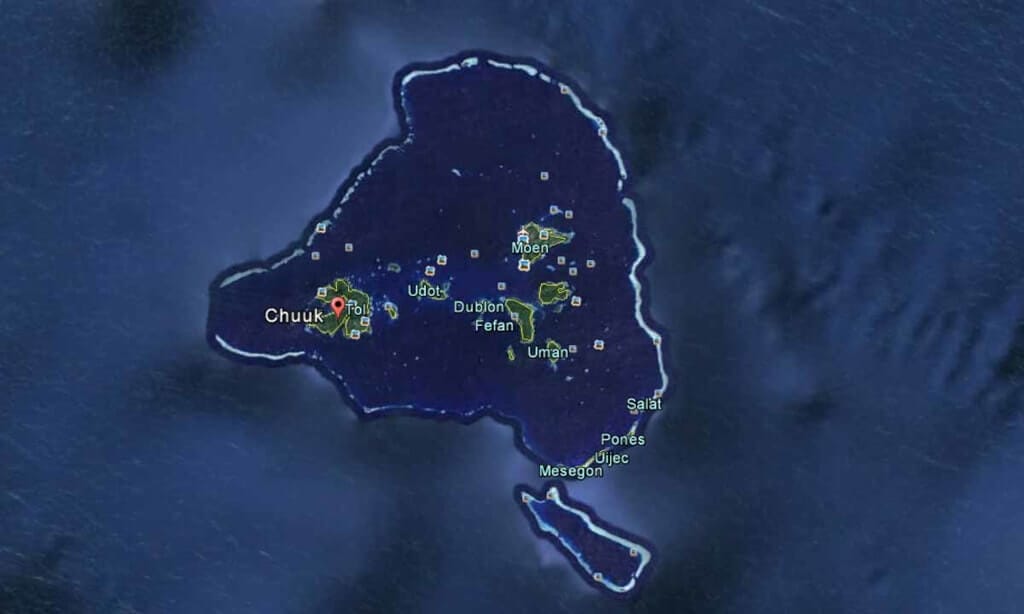
Truk Lagoon – a beautiful lagoon hiding many sunken wrecks
Truk Lagoon is at the same time a massive water surface surrounded by a coral reef – a typical lagoon to prevent ocean waves from getting in, and on the other hand, in the interior of this Lagoon there are a pair of massive volcanic islands – high steep cones that shield the anchorages from the wind, so it is a perfect combination of a lagoon and an anchorage between high islands.
There are two spaces in the area, at the bottom of which lie most of the wrecks sunk there. The first region is the area between Moen Island, Fefan Island and Dublon Island, and the second region is east of Dublon Island. A total of 38 massive wrecks lie at the bottom.

Aikoku Maru
85-meter long wreck of a troop transport ship, converted from a passenger ship, displacement 10,437 tons. Launched in 1940 and incorporated into the Japanese war fota in 1941. Armed with four 5.9-inch guns. It lies at the bottom east of Dublon Island. It sank after an explosion on February 17, 1944. The highest point of the wreck lies at 26 meters deep the bottom is at 64 meters. The wreck is devoid of a bow. A 4.7-inch cannon is visible on the stern. On the deck a rotating two-barrel 13.2mm anti-aircraft gun.
Amagisan Maru
Passenger and transport ship, 7620 tons, 137 meters long. Launched in 1933. The wreck lies between the islands of Fefan and Uman. The wreck lies (bottom) between 42 and 60 meters (from the stern). On the port side from the bow you can see a huge chain coming out of the key and dropping to the bottom. Next to the wreckage lies a 2-ton TX40 light tank. In the second hold lie aircraft parts and aircraft bombs. A well-preserved machine telegraph can be seen in the wheelhouse. In the superstructure and next to it in the sand lies a lot of porcelain.
Betty Bomber
The wreck of a Japanese bomber (Mitsubishi G4M Hammocks) armament a 20mm cannon and four machine guns. The crew consisted of 7 people.
Lying to the southwest of the island of Eten.
Wreckage of a long-range bomber mass-produced since 1940
Fujikawa Maru
Built in 1938, the passenger and transport ship. 6938 tons of displacement. 133 meters in length. It sank on the morning of February 18 after an additional attack. One of the most interesting wrecks of the Truk lagoon. The stern shows a heavily overgrown 6-inch gun. In the hold as in several other massive wrecks of the lagoon lie the hulls of Zero fighters.
Fumitsuki
Destroyer 1930 tons of displacement, 97 meters long. The wreck lies between 30 and 39 meters deep.The wreck lies west of Moen Island, at a depth of between 30 and 38 meters. A 4.7-inch cannon can be seen on the bow. Crates of ammunition lie nearby. Toward the stern, 24-inch torpedo launchers can be seen behind the cannon. The superstructure with the wheelhouse has fallen off and lies on the bottom next to the wreck. A depth bomb thrower can be seen on the stern.
Heian Maru
Built in 1930, the passenger-transport ship. She was a supply ship of the submarine fleet hence, for example, the spare periscopes in the descent corridors (that’s where they were located)
Length 155 meters, displacement 11,614 tons. An interesting feature of the wreck is the massive bolt under the stern and the Heian inscription on the bow. There are also torpedoes (21 inch) in the holds. At the stern the bottom is at 37 meters, at the bow at 27 meters.
Hoki Maru
The wreck discovered by Jacques Cousteau’s team later “disappeared” and was not found until 1973.
Launched in 1921
Displacement 10,850 tons, two screws, length 138 meters
It was captured and taken over by the Japanese in July 1942.
A powerful bulldozer, tractors and trucks are on board. The bow is detached from the midship and tilted to the right, from the deck you can dive into five holds,(the fifth is covered with planks).
Kiyosumi Maru
Launched in 1934, the passenger and transport ship.
Length 139 meters , displacement 8614 tons.
He sailed regularly to US and European ports. It was converted to a warship in August 1941. He participated in the famous (Tokyo Express) night raids with soldiers and equipment on Guadalcanal. It lies on the port side between 31 and 37 meters deep (bottom). It lies to the east of Fefan Island. Called “Dripping Oil” by local fishermen because of a long-standing oil spill.
Naka Maru
A light cruiser (a rare warship among the wrecks of Truk).
158 meters long, 5,195 tons of displacement, seven 5.5-inch guns.
Nippo Maru
Transport-passenger, ship built in 1936.
168 meters long, displacement 3764 tons.
He was drafted into the fleet in 1941. It lies at the bottom east of Dublon Island. On deck near the second hold is a beautifully preserved tank.
Dive depths between 28 and 50 meters.
Rio de Janeiro Maru
Submarine supply ship.
Displacement, 9,626 tons. 167 meters in length.
Beautifully preserved engine room. A large (6 inch) cannon on the stern.
The mighty screw at the stern is the perfect place for photos.
San Francisco Maru
Beautiful. Transport and passenger ship built in 1919.
Displacement 5831 tons
Length 118 meters
It sank like most of the Truk lagoon wrecks on February 17, 1944.
It lies at more than sixty meters on an even keel. It is one of the deepest wrecks in the Truk lagoon. In front of the superstructure, three light tanks with 37mm cannons and 7.7mm machine guns stand on deck. The two on the starboard side are thrown at each other most likely when the airplane bomb exploded. In the first hold you can spot a massive 800 kg bomb almost 2 meters long. In the second hold are two large trucks. A large amount of fine porcelain can be spotted in the superstructure.
Seiko Maru
Built in 1940, the transport ship. Displacement of 5385 tons. 120 meters in length.
The Seiko Maru, after being torpedoed, was towed to a base on Truku where it sank after a bomb attack on February 17, 1944. The wreck of the Seiko Maru was discovered by Jacques Cousteau’s expedition. The wreck lies at 49 meters east of Eten Island. In the first hold you can see powerful (stripped of heads and screws) Japanese torpedoes (Long Lances).
Unkai Maru
3220 tons of displacement, 101 meters long.
Transporter
Built in Britain in 1905 purchased by a Japanese company in 1911.
The wreck of the Unkai Maru was discovered by Jacques Cousteau’s expedition and then “rediscovered” in 1980. The wreck stands on an even keel at a depth of 40 meters, 600 meters north of Uman Island.
Yamagiri Maru
Passenger-transport ship. 6438 tons. 134 meters in length. Launched in 1938
Powerful 14-inch (355mm) artillery shells for Japanese battleships lie in the fifth hold.
The wreck lies on the port side about one mile off the northern edge of Fefan Island at a depth of 33 meters.
Finally, a small mention
I remember how we plunged along the descent over the legendary wreck of the San Francisco Maru , One of the most beautiful wrecks of the Truk Lagoon. The bottom was very deep at 60 meters, but the wreck stands on an even keel so the deck and especially the superstructures are a little shallower. Already after a few meters of sinking in the depths, as soon as the direct sunlight was cut off a little, we saw a huge wreck below us and began to descend on it. Such a dive requires a lot of agility to fit into the dive plan in relation to the planned and possible decompression and see what the guides want to show .What you want to see. The amazing space of the decks, superstructures, the light tanks lying on the deck are all things that really make an incredible impression.









